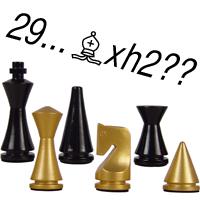
Blunders in Modern Play, Part 5
Today's article features four endgames from the 14th Karpov Tournament in Poikovsky, which was recently won by the Ukrainian GM Pavel Eljanov. His spectacular wins are outlined by FM Mike Klein in a recent post, so here I will concentrate on endgames played by the other participants. Once again, the topic is blunders, in this case by 2600+ players. Let's get started!
For the inexperienced eye, the position below might seem close to equality: there is material equilibrium and each side has some advantages. However, this evaluation is incorrect! White has a very strong advantage. This is due to the weak g7-square and the presence of opposite-colored bishops. White's plan is simple and unstoppable: Bc3, h5, Rg5 and capturing on g7.
Black's pawn majority on the queenside is useless for now because his king is in danger. In fact, Black cannot trade all four rooks because the c5-pawn is under attack. Generally, exchanging pieces favors the defending side, and ideally Black wants to trade queens, so that his king will be less vulnerable. Black can even sacrifice a pawn on the queenside if he manages to exchange all the pawns there and try drawing the endgame with 3 vs. 2 pawns on the kingside. GM Alexander Onischuk followed a strategy of piece-activation: he sacrificed a pawn but opened up the lines for the rook and queen.
It seems that the worst is behind, as Black managed to exchange one pair of rooks and position his queen on the super-strong a1-h8 diagonal. The importance of the piece geometry is that the white bishop cannot get on the crucial a1-h8 diagonal - so it cannot attack the weakness on g7! White can regroup to get the bishop on the long diagonal, when Black's defensive strategy would be putting the queen on f7, where it controls the important h5 and f5 squares and defends g7. White will have small edge in the resulting position but no more than that. In the game Onischuk blundered playing 33... Rd8??, after which the g7-square is impossible to defend. He resigned after several more moves.
Emil Sutovsky shows nice technique in the above example, as it was far from trivial to outplay Onischuk even after the blunder. The weakness of g7 reappeared in his game against Viktor Bologan, where Black blundered a whole piece!
The position is far from easy for Black due to his weak king and super-active white pieces; however, there is no need to give up a piece. The problem is that Black will eventually lose the a6- and b6-pawns because his pieces will be tied down to the kingside defense. Ideally, as in the previous example, Bologan wants to swap queens, but it is not easy to achieve. If the knight moves as in the game, Bb7 hangs, so Black can move the bishop first and only then exchange the knights. Only time-trouble can explain this oversight.
The last two examples are from Ernesto Inarkiev's play, who managed to collect 1.5 points, although objectively, based on the evaluation of the positions it should have been only half a point! The computer evaluates the following position as equal, which makes sense as Black most likely will win back the pawn and will have the more favorable R+B tandem. What happened in the game is inexplicable. White pawn-rolled Black on the kingside, where 7 out of the next 11 moves were made by the black bishop. Instead of going after the a6-pawn right away, Black could have postponed it for one move and won a tempo with 35...Bf6. The idea is to meet the f4-e5 threat with a blocking ...e5 or undermining ...g5.
In this critical position it is about time to take the a6-pawn. The f6 push is looming but after that, the e5-e6 push is not easy to implement because the black rook controls the 6th rank. With two passed pawns — on the a- and d-file — Black will have enough distraction to keep White's forces away from the goal of pushing pawns forward. Instead, Viktor Laznicka played a mysterious bishop maneuver, after which he pretty much lost two tempi (the bishop could have gotten to f8 in one move) and the position became decisive for White.
The last example is a highly complex R+N endgame, where Black has a passed a-pawn. It turns out that the evaluation of the endgame is close to equal despite the passed a-pawn due to White's active pieces and threat of collecting the g- and h-pawns. After that, it is the h-pawn that might decide the game. Black's pieces are bit tangled-up on the queenside — the rook is in front of the pawn and the knight does not have a strong place to stay. White can coordinate his pieces to launch an attack on black king. The king will have to decide whether to abandon the kingside pawns and make a race of it. Or the king can hang our around the kingside pawns, but in that case White will easily find a perpetual check if not more.
Hence, we figured out that the white R+N is a powerful tandem and can cause some damage to the black king. In the game, to my surprise, Inarkiev decided to go into a knight endgame! Knight endgames are similar to pawn endgames, where the passed-pawn is one of the most decisive factors. The position became winning for Onischuk, although not without technical difficulties.
The endgame is very interesting and deserves a detailed analysis. Here, I concentrate on two key moments only, but if you have time, exploring this endgame can be very beneficial. White managed to create some counterplay. If he gives up the knight for the a-pawn and the f-pawn falls then the endgame will most likely be a draw. Onischuk has a spectacular knight sacrifice that serves as a deflection for the white knight. It can be implemented now or few moves later. All the other continuations lead to draw, as the white knight effectively holds the a-pawn.
Next week we will see more endgame blunders....
RELATED STUDY MATERIAL
- Read more articles in this series on blunders in modern play;
- Watch GM Dejan Bojkov's video series Attacks with Opposite-Coloured Bishops;
- Read WIM Iryna Zenuyk's article Extra Pawn vs. Activity;
- Read GM Vinay Bhat's article Rolling, Rolling, Rolling: Pawn Power;
- Watch videos about knight endgames.






